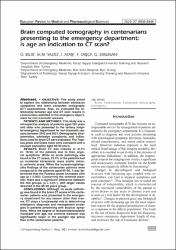| dc.contributor.author | Bilir, Özlem | |
| dc.contributor.author | Yazıcı, Mümin Murat | |
| dc.contributor.author | Ataş, İsmail | |
| dc.contributor.author | Taşçı, Filiz | |
| dc.contributor.author | Ersunan, Gökhan | |
| dc.date.accessioned | 2023-10-25T06:11:32Z | |
| dc.date.available | 2023-10-25T06:11:32Z | |
| dc.date.issued | 2023 | en_US |
| dc.identifier.citation | Bilir, Ö., Yazici, M. M., Ataş, I., Taşçi, F., & Ersunan, G. (2023). Brain computed tomography in centenarians presenting to the emergency department: is age an indication to CT scan?. European review for medical and pharmacological sciences, 27(15), 6939–6946. https://doi.org/10.26355/eurrev_202308_33266 | en_US |
| dc.identifier.issn | 1128-3602 | |
| dc.identifier.issn | 2284-0729 | |
| dc.identifier.issn | 1128-3602 | |
| dc.identifier.uri | https://doi.org/10.26355/eurrev_202308_33266 | |
| dc.identifier.uri | https://hdl.handle.net/11436/8572 | |
| dc.description.abstract | OBJECTIVE: This study aimed
to explore the relationship between admission
complaints and brain computed tomography
(CT) examinations. Also, we evaluated the relationship between age and CT scan results in
centenarians admitted to the emergency department for non-traumatic reasons.
PATIENTS AND METHODS: This study was a
retrospective analysis of patients aged 100 years
and older who presented to the tertiary hospital emergency department for non-traumatic reasons between 2012 and 2021. Demographic characteristics, admission complaints, and indications used for brain CT were evaluated. The Fazekas grade and Evans index were compared with a
younger population aged 85-90 years.
RESULTS: Brain CT was ordered in 41.1%
(n: 15/34) of the patients due to their atypical symptoms. While no acute pathology was
found in the CT scans, 23.5% of the patients had
an incidental intracranial mass and/or chronic ischemic areas. When the leukoencephalopathy findings of the centenarian patients were
compared to the patients aged 85-90, it was determined that the Fazekas grade increased with
age (p = 0.002). Concerning the ventricle diameter, there was a significant difference between
the two groups (p = 0.017), with larger values
detected in the 85-90 years group.
CONCLUSIONS: Although no acute pathology was found in the brain CT scans of the centenarian patients who presented to the emergency department for any reason other than trauma, CT plays a fundamental role in determining
emergency diagnosis and management strategies in patients presenting with atypical symptoms. While the degree of leukoencephalopathy
increased with age, the ventricle diameter was
significantly larger in the younger age group
than in the centenarian patients. | en_US |
| dc.language.iso | eng | en_US |
| dc.rights | info:eu-repo/semantics/openAccess | en_US |
| dc.subject | Brain | en_US |
| dc.subject | Centenarian | en_US |
| dc.subject | Computed tomography | en_US |
| dc.subject | Emergency | en_US |
| dc.title | Brain computed tomography in centenarians presenting to the emergency department: is age an indication to CT scan? | en_US |
| dc.type | article | en_US |
| dc.contributor.department | RTEÜ, Tıp Fakültesi, Cerrahi Tıp Bilimleri Bölümü | en_US |
| dc.contributor.institutionauthor | Bilir, Özlem | |
| dc.contributor.institutionauthor | Yazıcı, Mümin Murat | |
| dc.contributor.institutionauthor | Taşçı, Filiz | |
| dc.contributor.institutionauthor | Ersunan, Gökhan | |
| dc.identifier.doi | 10.26355/eurrev_202308_33266 | en_US |
| dc.identifier.volume | 27 | en_US |
| dc.identifier.issue | 15 | en_US |
| dc.identifier.startpage | 6939 | en_US |
| dc.identifier.endpage | 6946 | en_US |
| dc.relation.journal | European Review for Medical and Pharmacological Sciences | en_US |
| dc.relation.publicationcategory | Makale - Uluslararası Hakemli Dergi - Kurum Öğretim Elemanı | en_US |


















